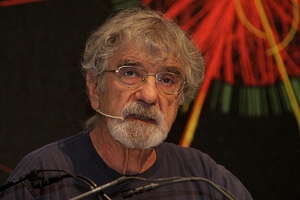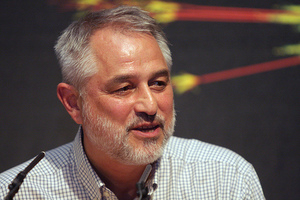Badly designed to understand the Universe
CERN's LHC in critical Reflection by great Philosopher H. Maturana and Astrophysicist R. Malina
Famous Chilean philosopher Humberto Maturana describes ’certainty in science as subjective emotional opinion and astonishes the physicists prominence. French astronomer and ’Leonardo publisher Roger Malina hopes that the LHC safety issue would be discussed in a broader social context and not only in the closer scientific framework of CERN.
The latest renowned ’Ars Electronica Festival in Linz (Austria) was dedicated in part to an uncritical worship of the gigantic particle accelerator LHC (Large Hadron Collider) at the European Nuclear Research Center CERN located at the Franco-Swiss border. CERN in turn promoted an art prize with the idea to ’cooperate closely with the arts. This time the objections were of a philosophical nature and they had what it takes.
In a thought provoking presentation Maturana addressed the limits of our knowledge and the intersubjective foundations of what we call ’objective and ’reality. His talk was spiked with excellent remarks and witty asides that contributed much to the accessibility of these fundamental philosophical problems: ’Be realistic, be objective! Maturana pointed out, simply means that we want others to adopt our point of view. The great constructivist and founder of the concept of autopoiesis clearly distinguished his approach from a solipsistic position.
Given Ars Electronicas spotlight on CERN and its experimental sub-nuclear research reactor, Maturanas explanations were especially important, which to the assembled CERN celebrities may have come in a mixture of an unpleasant surprise and a lack of relation to them.
During the question-and-answer period, Markus Goritschnig asked Maturana whether it wasnt problematic that CERN is basically controlling itself and discarding a number of existential risks discussed related to the LHC - including hypothetical but mathematically demonstrable risks also raised - and later downplayed - by physicists like Nobel Prize winner Frank Wilczek, and whether he thought it necessary to integrate in the LHC safety assessment process other sciences aside from physics such as risk search. In response Maturana replied (in the video from about 1:17): ’We human beings can always reflect on what we are doing and choose. And choose to do it or not to do it. And so the question is, how are we scientists reflecting upon what we do? Are we taking seriously our responsibility of what we do? [
] We are always in the danger of thinking that, Oh, I have the truth, I mean - in a culture of truth, in a culture of certainty - because truth and certainty are not as we think - I mean certainty is an emotion. I am certain that something is the case means: I do not know. [
] We cannot pretend to impose anything on others; we have to create domains of interrogativity.
Disregarding these reflections, Sergio Bertolucci (CERN) found the peer review system among the physicists community a sufficient scholarly control. He refuted all the disputed risks with the ’cosmic ray argument, arguing that much more energetic collisions are naturally taking place in the atmosphere without any adverse effect. This safety argument by CERN on the LHC, however, can also be criticized under different perspectives, for example: Very high energetic collisions could be measured only indirectly - and the collision frequency under the unprecedented artificial and extreme conditions at the LHC is of astronomical magnitudes higher than in the Earth's atmosphere and anywhere else in the nearer cosmos.
The second presentation of the ’Origin Symposium III was held by Roger Malina, an astrophysicist and the editor of ’Leonardo (MIT Press), a leading academic journal for the arts, sciences and technology.
Malina opened with a disturbing fact: ’95% of the universe is of an unknown nature, dark matter and dark energy. We sort of know how it behaves. But we dont have a clue of what it is. It does not emit light, it does not reflect light. As an astronomer this is a little bit humbling. We have been looking at the sky for millions of years trying to explain what is going on. And after all of that and all those instruments, we understand only 3% of it. A really humbling thought. [
] We are the decoration in the universe. [
] And so the conclusion that Id like to draw is that: We are really badly designed to understand the universe.
The main problem in research is: ’curiosity is not neutral. When astrophysics reaches its limits, cooperation between arts and science may indeed be fruitful for various reasons and could perhaps lead to better science in the end. It probably would have led too far for the speaker to additionally differentiate the relationship between natural and social science in this concern.
However, the astronomer emphasized that an ’art-science collaboration can lead to better science in some cases. It also leads to different science, because by embedding science in the larger society, I think the answer was wrong this morning about scientists peer-reviewing themselves. I think society needs to peer-review itself and to do that you need to embed science differently in society at large, and that means cultural embedding and appropriation. Helga Nowotny at the European Research Council calls this socially robust science. The fact that CERN did not lead to a black hole that ended the world was not due to peer-review by scientists. It was not due to that process.
One of Malinas main arguments focused on differences in ’the ethics of curiosity. The best ethics in (natural) science include notions like: intellectual honesty, integrity, organized scepticism, dis-interestedness, impersonality, universality. ’Those are the believe systems of most scientists. And there is a fundamental flaw to that. And Humberto this morning really expanded on some of that. The problem is: Curiosity is embodied. You cannot make it into a neutral ideal of scientific curiosity. And here I got a quote of Humbertos colleague Varela: ’All knowledge is conditioned by the structure of the knower.
In conclusion, a better co-operation of various sciences and skills is urgently necessary, because: ’Artists asks questions that scientists would not normally ask. Finally, why we want more art-science interaction is because we dont have a choice. There are certain problems in our society today that are so tough we need to change our culture to resolve them. Climate change: weve got to couple the science and technology to the way we live. Thats a cultural problem, and we need artists working on that with the scientists every day of the next decade, the next century, if we survive it.
Then Roger Malina directly turned to the LHC safety discussion and articulated an open contradiction to the safety assurance pointed out before: He would generally hope for a much more open process concerning the LHC safety debate, rather than discussing this only in a narrow field of particle physics, concrete: ’There are certain problems where we cannot cloister the scientific activity in the scientific world, and I think we really need to break the model. I wish CERN, when they had been discussing the risks, had done that in an open societal context, and not just within the CERN context.
Presently CERN is holding its annual meeting in Chamonix to fix LHCs 2012 schedules in order to increase luminosity by a factor of four for maybe finally finding the Higgs Boson against a 100-Dollar bet of Stephen Hawking who is convinced of Micro Black Holes being observed instead, immediately decaying by hypothetical ’Hawking Radiation - with God Particles blessing. Then it would be himself gaining the Nobel Prize Hawking pointed out. Quite ironically, at Ars Electronica official T-Shirts were sold with the ’typical signature of a micro black hole decaying at the LHC by a totally hypothetical process involving a bunch of unproven assumptions.
In 2013 CERN plans to adapt the LHC due to construction failures for up to CHF 1 Billion to run the ’Big Bang Machine at double the present energies. A neutral and multi-disciplinary risk assessment is still lacking, while a couple of scientists insist that their theories pointing at even global risks have not been invalidated. CERNs last safety assurance comparing natural cosmic rays hitting the Earth with the LHC experiment is only valid under rather narrow viewpoints. The relatively young analyses of high energetic cosmic rays are based on indirect measurements and calculations. Sort, velocity, mass and origin of these particles are unknown. But, taking the relations for granted and calculating with the ’assuring figures given by CERN PR, within ten years of operation, the LHC under extreme and unprecedented artificial circumstances would produce as many high energetic particle collisions as occur in about 100.000 years in the entire atmosphere of the Earth. Just to illustrate the energetic potential of the gigantic facility: One LHC-beam, thinner than a hair, consisting of billions of protons, has got the power of an aircraft carrier moving at 12 knots.
This article in the Physics arXiv Blog (MITs Technology Review) reads: ’Black Holes, Safety, and the LHC Upgrade - If the LHC is to be upgraded, safety should be a central part of the plans., closing with the claim: ’Whats needed, of course, is for the safety of the LHC to be investigated by an independent team of scientists with a strong background in risk analysis but with no professional or financial links to CERN.
www.technologyreview.com - Update: Black Holes, Safety, and the LHC
Australian ethicist and risk researcher Mark Leggett concluded in a paper that CERNs LSAG safety report on the LHC meets less than a fifth of the criteria of a modern risk assessment. There but for the grace of a goddamn particle? Probably not. Before pushing the LHC to its limits, CERN must be challenged by a really neutral, external and multi-disciplinary risk assessment.
Video recordings of the ’Origin III symposium at Ars Electronica:
Presentation Humberto Maturana:
Presentation Roger Malina:
’Origin Symposia at Ars Electronica:
www.aec.at/origin/category/conferences
German original of this article:
Abstrakte und konkrete Kritik an CERN von H. Maturana und R. Malina auf der Ars Electronica
More info, links and transcripts of lectures at ’LHC-Critique - Network for Safety at experimental sub-nuclear Reactors:
www.LHC-concern.info
Artikel Online geschaltet von: / Doris Holler /


